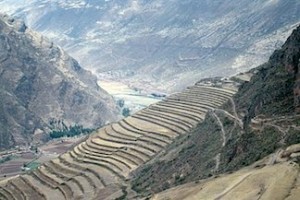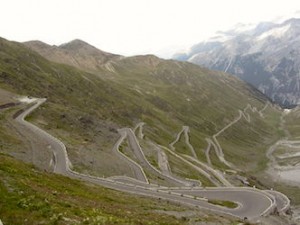Simple machines are the basis of industry. Well, sorta.
 A simple machine is a device used to change the direction or power of a force applied to something in the simplest manner possible. There are six devices classically categorized as simple machines: axles and wheels, levers, pulleys, screws, wedges, and inclined planes (obviously the best).
A simple machine is a device used to change the direction or power of a force applied to something in the simplest manner possible. There are six devices classically categorized as simple machines: axles and wheels, levers, pulleys, screws, wedges, and inclined planes (obviously the best).
The reason I said they’re only sorta the basis for industry, though, is that the idea of simple machines is itself an oversimplification.
First off, take a look at wedges and screws. A screw is nothing more than an inclined plane wrapped around a cylinder. When you’re turning a screw, picture it inside the material—climbing up or down the ramp—as the screw turns. Wedges are just two ramps hooked up to one another, bottom to bottom, for use in transferring force perpendicularly.
Ramps make up half of the classical simple machines. Ramps rule, but we already knew that.
Then you come to wheels and axles and pulleys. A pulley is just a wheel and axle with a rope attached. It’s still super useful, of course.
 At first glance, our final classical simple machine, the lever, is pretty distinct from the others. A guy named Franz Reuleaux, however, realized that, like the wheel and pulley, the lever is just a body rotating about a hinge. Reuleaux was also the one who figured out that the screw, wedge, and inclined plane were the same. Really smart cookie.
At first glance, our final classical simple machine, the lever, is pretty distinct from the others. A guy named Franz Reuleaux, however, realized that, like the wheel and pulley, the lever is just a body rotating about a hinge. Reuleaux was also the one who figured out that the screw, wedge, and inclined plane were the same. Really smart cookie.
So all in all, you’ve really got two simple machines and four variants on the original list. And that’s the first issue with describing the classical simple machines as the basis of mechanical industry.
The second issue? There are a lot more than six simple machines. You’ve got four-bar linkages and cranks, for example. Our good buddy Franz identified hundreds of simple machines using his self-invented science of Kinematics, which we still use today. Way to go, Franz. Not bad for a guy born in 1829.
Nowadays, thanks to Franz and Kinematics, we actually consider joints the basis of mechanics, but that’s a story for another day.
 Terraces might be something of an opposite of ramps, but that just makes them more fascinating. Living among some of the steepest mountains in the world, the Incans had to improvise heavily when it came to all sorts of facets of their life. Their terraces did a lot more than provide flat areas for food production (though don’t get me wrong: that was just a little bit important); they also helped to control erosion and landslides.
Terraces might be something of an opposite of ramps, but that just makes them more fascinating. Living among some of the steepest mountains in the world, the Incans had to improvise heavily when it came to all sorts of facets of their life. Their terraces did a lot more than provide flat areas for food production (though don’t get me wrong: that was just a little bit important); they also helped to control erosion and landslides. The most famous are almost certainly the rice terraces of the Philippine Cordilleras: they’ve actually been declared a UNESCO heritage site. You’ve almost certainly seen images of them before. They’ve been farmed continuously for something like 2000 years, which is absolutely crazy. That’s not just architecture, it’s a way of life.
The most famous are almost certainly the rice terraces of the Philippine Cordilleras: they’ve actually been declared a UNESCO heritage site. You’ve almost certainly seen images of them before. They’ve been farmed continuously for something like 2000 years, which is absolutely crazy. That’s not just architecture, it’s a way of life. One of the craziest examples of the breed is the
One of the craziest examples of the breed is the  With ramps, friction is the biggest variable left out; it’s a real pain to calculate. Often, teachers will just do the math with an idealized, frictionless ramp. Makes it really easy for students to figure out but gets a little ridiculous if you try to think about actually trying to use the thing—pure slapstick, really, and slapstick is one kind of humor you don’t want in the workplace.
With ramps, friction is the biggest variable left out; it’s a real pain to calculate. Often, teachers will just do the math with an idealized, frictionless ramp. Makes it really easy for students to figure out but gets a little ridiculous if you try to think about actually trying to use the thing—pure slapstick, really, and slapstick is one kind of humor you don’t want in the workplace. Well, come the day he was to test out the idea, it turns out I’d taught him with the idealized frictionless ramp model. That should have resulted in a mess on its own but, luckily for me, his big mistake had nothing to do with my assistance.
Well, come the day he was to test out the idea, it turns out I’d taught him with the idealized frictionless ramp model. That should have resulted in a mess on its own but, luckily for me, his big mistake had nothing to do with my assistance. Anyhow, ramps at different gravity levels: generally speaking, they’re much more useful at the higher ones. If you’re in zero g, just floating around, a ramp is going to be pretty pointless. As gravity gets higher, though, more and more solutions for bridging vertical distances (or, as I prefer to call it, going up and down) become infeasible.
Anyhow, ramps at different gravity levels: generally speaking, they’re much more useful at the higher ones. If you’re in zero g, just floating around, a ramp is going to be pretty pointless. As gravity gets higher, though, more and more solutions for bridging vertical distances (or, as I prefer to call it, going up and down) become infeasible. As far as I know, there’s only one book where a ramp saves the day, and that’s
As far as I know, there’s only one book where a ramp saves the day, and that’s